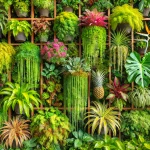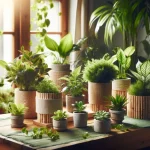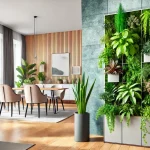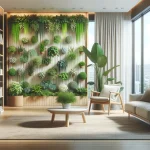This post may contain affiliate links. If you buy something from one of our links we may earn a commission. Thanks
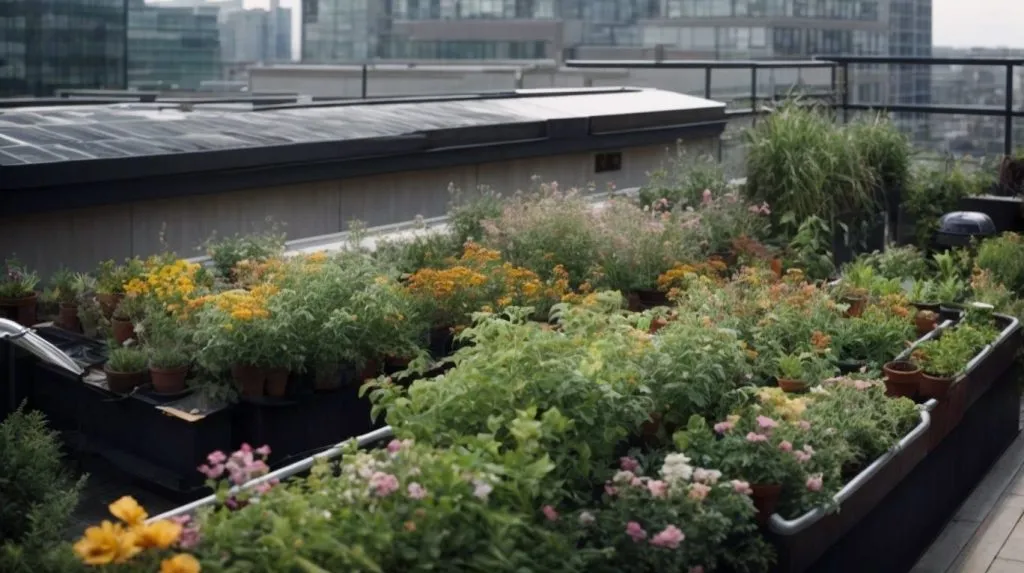
Discover the benefits of watering systems for rooftop gardens! Learn how to keep your urban oasis thriving with efficient, targeted irrigation solutions.
Watering Systems for Rooftop Gardens
Key Takeaways:
- Watering systems for rooftop gardens are designed to provide efficient and targeted irrigation to plants in urban settings.
- These systems, such as drip irrigation, soaker hoses, and automated sprinklers, ensure that water is delivered directly to the plant roots, minimizing waste and promoting healthy growth.
- They are ideal for conserving water and maintaining the vitality of rooftop gardens in various climates.
Are you looking to transform your rooftop into a vibrant garden oasis? Explore the world of watering systems for rooftop gardens!
These innovative solutions provide efficient and precise watering, ensuring your plants stay healthy and lush. Join us as we delve into the best watering systems for your rooftop garden, helping you create a green retreat in the heart of the city.
Watering Systems for Rooftop Gardens
We explore the world of rooftop gardens and the importance of watering systems. From the challenges of watering rooftop gardens to the different types of watering systems available, we guide you through the process of selecting the best system for your garden.
Stay tuned for tips on installation, maintenance, and troubleshooting to ensure your rooftop oasis thrives.
What Are Rooftop Gardens?
Rooftop gardens refer to green spaces created atop buildings, providing opportunities for urban agriculture and sustainable practices in densely populated areas.
These gardens play a crucial role in combating issues such as food insecurity and urban heat islands.
By utilizing innovative techniques like SIPs (Sub-Irrigated Planters), rooftop gardens can significantly reduce water consumption and improve plant growth by providing a consistent water supply.
In cities like Vancouver, where space is limited, these green spaces contribute to increased biodiversity, improved air quality, and enhanced aesthetic appeal.
Why Are Watering Systems Important for Rooftop Gardens?
Watering systems play a crucial role in rooftop gardens by ensuring efficient water distribution, minimizing water consumption, and promoting plant growth, with solutions like Netafim’s drip irrigation system leading the way.
Implementing an effective watering system in rooftop gardens is essential for maintaining healthier plants while conserving water resources.
Drip irrigation, such as Netafim, operates by delivering precise amounts of water directly to the plant roots, reducing water waste and evaporation.
This method not only optimizes water usage but also helps prevent soil erosion and minimizes weed growth.
Advanced technologies like smart controllers and soil moisture sensors further enhance the efficiency of watering systems.
These innovations enable automated irrigation schedules based on plant needs and environmental conditions, ensuring optimal hydration levels for plants without overwatering.
What Are the Challenges of Watering Rooftop Gardens?
The challenges of watering rooftop gardens include issues like drainage, evaporation, and the impact of high winds, necessitating solutions like those offered by New York Plantings Irrigation.
Proper drainage is crucial for rooftop gardens to prevent water logging and potential structural damage from excess weight load. Effective irrigation systems need to consider the balance between watering the plants sufficiently without causing water stagnation.
Evaporation in rooftop gardens is accelerated due to exposure to direct sunlight, requiring frequent watering to maintain optimal moisture levels.
This can lead to increased water consumption and the need for efficient irrigation practices.
To prevent roots from damaging the roof structure, techniques like using lightweight soil and root barriers are employed.
These methods help maintain the integrity of the rooftop while promoting healthy plant growth.
What Are the Different Types of Watering Systems for Rooftop Gardens?
Various types of watering systems cater to rooftop gardens, including drip irrigation systems, micro-spray solutions, soaker hoses, automated sprinklers, and self-watering containers, each offering distinct advantages.
With their precision in water delivery, drip irrigation systems are ideal for conserving water and promoting plant health by directly targeting the base of plants.
On the other hand, micro-spray solutions provide gentle, fine mist over a broader area, making them suitable for densely planted or delicate crops.
Soaker hoses offer a slow and steady release of water, ideal for long garden rows or planters in need of consistent moisture.
Automated sprinklers bring convenience by covering larger areas with uniform watering, while self-watering containers are perfect for smaller spaces, providing a self-regulated hydration system.
Drip Irrigation Systems
Drip irrigation systems are a popular choice for rooftop gardens, with sub-irrigation methods and advanced features like Netafim’s pressure regulators ensuring efficient and targeted watering for plants.
Sub-irrigation techniques in drip irrigation involve delivering water directly to the root zone of plants, minimizing water loss due to evaporation and runoff.
The use of pressure regulators in these systems helps maintain uniform water distribution across the entire garden, preventing overwatering or underwatering of plants.
Netafim’s cutting-edge technology not only ensures precise control over water flow and distribution but also contributes to water conservation and promotes healthy plant growth through optimal moisture levels.
Micro-spray Irrigation Systems
Micro-spray irrigation systems offer a fine mist for watering rooftop gardens, but challenges like high winds and low pressure can affect their effectiveness, requiring special considerations.
In terms of combating wind resistance, micro-spray systems often feature adjustable nozzles that can help disperse the mist in a controlled manner, minimizing the impact of turbulent air currents.
Proper pressure adjustments are crucial to ensure that the mist reaches its intended target without being dispersed off course, especially in windy conditions.
Regular maintenance is key in keeping these systems working efficiently, as clogged nozzles or damaged components can impede proper functioning.
In fact, National Geographic has highlighted the importance of maintaining irrigation systems to conserve water and promote sustainable gardening practices.
Soaker Hoses
Soaker hoses provide direct root access to water, allowing efficient nutrient absorption, but challenges like drought conditions necessitate careful monitoring and supplementary nutrient resources.
One of the primary benefits of utilizing soaker hoses lies in their ability to deliver water directly to the root zones of plants, ensuring optimal absorption of essential nutrients by bypassing surface evaporation.
By maintaining moisture levels at the root level, soaker hoses enhance the resilience of plants during periods of drought, reducing the impact of water stress on growth and development.
This targeted watering method minimizes water wastage and aids in efficient resource management by preventing runoff and optimizing water usage through a reservoir system that caters to the plant’s transpiration needs.
Automated Sprinkler Systems
Automated sprinkler systems offer convenient watering solutions for rooftop gardens, but regular maintenance and adjustment are essential to ensure optimal performance and water efficiency.
One of the key advantages of utilizing automated sprinkler systems in rooftop gardens is the ability to deliver precise amounts of water to different plant varieties, ensuring they receive adequate hydration without wastage.
To harness these benefits effectively, it’s crucial to conduct routine system checks and inspections to identify any potential issues.
Proper calibration of the sprinkler system is also critical in preventing overwatering or underwatering, which can lead to drainage problems and impact plant health.
Incorporating gravel stabilization techniques can help enhance the system’s efficiency by ensuring an even distribution of water across the garden terrain.
Self-watering Containers
Self-watering planters provide a self-sufficient solution for rooftop gardens, minimizing water loss due to evaporation and transpiration, with additional benefits like self-cleaning capabilities.
These innovative containers feature a reservoir that holds excess water, allowing plants to draw up water as needed, reducing the frequency of manual watering.
The design of these containers facilitates efficient plant hydration while preventing overwatering, making them ideal for individuals with busy schedules or those looking for a low-maintenance gardening option.
Their drought-resistant properties enable plants to thrive even in challenging environmental conditions, ensuring optimal growth and vitality.
Which Watering System is Best for Your Rooftop Garden?
Choosing the best watering system for your rooftop garden depends on factors such as garden size, climate conditions, plant types, maintenance requirements, and water source accessibility.
It is crucial to consider weight load capacity of your rooftop when selecting a watering system to prevent structural damage.
Assess the load-bearing capability of your rooftop before installing any irrigation system.
For a diverse range of plant species, drip irrigation systems are efficient, providing customized water delivery for different plant needs.
Factoring in local weather patterns can help determine the appropriate watering schedule to maintain plant health and conserve water.
Choose a system that aligns with your garden’s specific needs while being mindful of sustainability and efficiency.
Factors to Consider:
Several key factors should be considered when choosing a watering system for your rooftop garden, including the size and layout of the garden, water source availability, plant varieties, climate considerations, maintenance requirements, and overall cost.
Plant compatibility is essential to ensure that the watering system provides the right amount of water for different types of plants in your garden.
Researching the watering needs of your specific plant varieties can help optimize growth and prevent over or under-watering.
Weather adaptability is another crucial factor to evaluate. Your watering system should be able to adjust to varying weather conditions, providing adequate moisture during dry spells and avoiding waterlogging during heavy rain.
Financial implications play a significant role in selecting a watering system.
Consider the initial investment cost, ongoing maintenance expenses, and long-term savings on water bills when choosing between different watering options.
Size and Layout of Garden
The size and layout of your rooftop garden influence the choice of watering system, as larger gardens may require more complex systems and considerations for weight load distribution.
For larger rooftop gardens, drip irrigation systems may be more suitable due to their ability to deliver water directly to the roots of plants efficiently.
Considering the weight load distribution is crucial to prevent any structural damage to the building.
Some advanced systems incorporate sensors to measure soil moisture levels, automatically adjusting watering schedules for optimum plant health.
It’s important to factor in the water source availability, sun exposure, and plant types when selecting the ideal watering system for your rooftop garden.
Water Source and Pressure
The availability of a reliable water source and adequate pressure is essential for efficient watering in rooftop gardens, with solutions like Netafim’s drip irrigation benefiting from consistent pressure regulation.
Proper pressure regulation ensures that each plant receives the right amount of water, reducing the risk of over or under-watering.
Drip irrigation systems help conserve water by delivering it directly to the plant roots, minimizing evaporation and runoff.
Netafim’s technology also allows for precise control over the flow rate, ensuring uniform water distribution across the garden.
This not only promotes healthier plant growth but also reduces water wastage, making rooftop gardening more sustainable and environmentally friendly.
Type of Plants and Soil
Different plant types and soil compositions require specific watering approaches in rooftop gardens, with consideration for nutrient resources and soil characteristics playing a crucial role in system selection.
For succulents and drought-resistant plants, a watering schedule that allows the soil to fully dry out between waterings is recommended to prevent root rot.
On the other hand, leafy greens and herbs thrive with consistent moisture levels, requiring frequent but light watering sessions.
The composition of the growing medium is vital to water retention levels, with organic matter aiding in moisture retention and drainage.
Choosing the right irrigation system, such as drip irrigation or soaker hoses, is essential to deliver a precise amount of water directly to plant roots without waste.
Climate and Weather Conditions
The climate and prevailing weather conditions impact the watering needs of rooftop gardens, with factors like drainage efficiency and water retention critical for system effectiveness.
Proper irrigation scheduling is essential to ensure that rooftop gardens receive the right amount of water without overwatering or underwatering.
A combination of techniques, such as drip irrigation systems and rainwater harvesting, can help optimize water usage while promoting plant growth.
Selecting the appropriate drought-tolerant plants can further enhance the sustainability of rooftop gardens in regions prone to dry spells.
These plants require less frequent watering, making them ideal choices for environments where water conservation is paramount.
Maintenance and Cost
Considering the maintenance requirements and overall cost of a watering system is vital for long-term success in rooftop gardening, with expert services like those offered by New York Plantings Irrigation ensuring system longevity.
Proper maintenance not only prolongs the life of the system but also enhances its efficiency. It involves regular inspections, cleaning, and repair work.
Regular monitoring of water usage and system performance can help in identifying potential issues before they escalate.
Choosing high-quality materials and components initially might require a higher investment but can significantly reduce long-term costs.
How to Install a Watering System for Your Rooftop Garden?
Installing a watering system for a rooftop garden involves careful planning, design considerations, selection of appropriate tools and materials, and methodical implementation to ensure optimal functionality and plant health.
When planning the watering system, consider the location of the garden, sun exposure, types of plants, and water source availability.
These factors will dictate the type of system needed, whether drip irrigation, soaker hoses, or sprinklers.
Design considerations include layout, water pressure needs, and potential future expansion.
The right tools, such as tubing cutters, connectors, and timers, are necessary for a successful installation.
Materials like PVC pipes, emitters, and filters must be selected for durability and efficiency.
Implementing the system involves laying out the components, testing for leaks, and adjusting water flow for each plant’s specific needs.
A well-planned and executed watering system can significantly improve the health and vitality of your rooftop garden.
Step-by-Step Guide:
Follow this step-by-step guide to install a watering system for your rooftop garden, covering planning, design, installation of main water lines, setting up drip lines or hoses, placement of emitters or sprinklers, testing, and system adjustments for optimal performance.
When planning your watering system, consider factors such as sunlight exposure, plant types, and water requirements.
A well-designed system will ensure efficient water distribution to all areas of your rooftop garden.
Once the main water lines are installed, carefully lay out drip lines or hoses to deliver water directly to the plant roots.
Proper placement of emitters or sprinklers is crucial to avoid both overwatering and underwatering different areas.
Plan and Design Your System
Begin by carefully planning and designing your rooftop garden’s watering system, considering factors such as garden layout, plant distribution, and the incorporation of efficient solutions, like drip irrigation technology.
It is crucial to assess the sun exposure and wind patterns of your rooftop garden to determine the optimal placement of irrigation lines.
Drip irrigation offers precise water delivery directly to the plant roots, minimizing water waste and promoting plant health.
Incorporating a timer system can automate watering schedules, ensuring consistent moisture levels for your plants.
Remember to install a filtration system to prevent clogging and periodically check for leaks or blockages in the irrigation lines.
Gather Materials and Tools
Collect the necessary materials and tools for installing your rooftop garden’s watering system, ensuring the availability of quality components.
Before starting the installation process, it’s crucial to make a checklist of items required such as PVC piping, connectors, pressure regulators, timers, hoses, and spray heads.
Having a clear plan and design layout will streamline the process and ensure efficient water distribution across your garden area.
Considering factors like water pressure, sunlight exposure, and plant types will help tailor the system to fit your specific garden needs.
Don’t hesitate to seek advice from experienced professionals like New York Plantings Irrigation for guidance on system design and installation best practices.
Install the Main Water Line
The installation of the main water line is a critical step in setting up your rooftop garden’s watering system, requiring precise placement, connection to irrigation components, and consideration for drainage holes for efficient water flow.
Proper installation ensures that water reaches all areas of the garden adequately, promoting healthy growth and vitality of your plants.
When placing the water line, it is essential to account for the ideal depth to avoid interference with other underground utilities or plant roots.
Connecting the line to sprinklers, drip emitters, or soaker hoses enhances the distribution of water, catering to the specific needs of each plant.
Incorporating drainage holes at strategic points helps prevent water accumulation, reducing the risk of waterlogging and root rot.
Lay Out Drip Lines or Hoses
Carefully lay out drip lines or hoses in your rooftop garden to ensure even water distribution and targeted watering for plants.
By strategically placing the drip lines, you can avoid overwatering or underwatering specific areas of your garden, promoting healthier plant growth.
Efficient water usage is key to sustainable gardening practices.
Install Emitters or Sprinkler Heads
Properly place and install emitters or sprinkler heads in your rooftop garden to deliver water effectively to plants, considering maintenance requirements, water efficiency, and system longevity, with guidance from industry experts or resources.
When positioning the emitters or sprinklers in your rooftop garden, it is essential to ensure that they are strategically located to cover the entire garden area efficiently.
This involves understanding the water distribution patterns of each emitter or sprinkler head and the specific water needs of different plant species.
By following the advice of experts and leveraging resources you can optimize your watering system for maximum effectiveness in nurturing your rooftop garden.
This strategic placement will also contribute to the sustainability and health of your plants over the long term.
Test and Adjust System
Conduct thorough testing of your rooftop garden’s watering system to ensure proper functionality, adjust settings for optimal performance, and consider factors like climate and weather conditions that may impact water distribution and plant health.
Testing the watering system involves checking irrigation lines for leaks or clogs, calibrating sprinkler heads for even water distribution, and monitoring moisture levels in the soil.
It’s essential to fine-tune the settings based on the specific needs of your garden plants to avoid over or under-watering.
Climate and weather conditions play a crucial role in determining the watering schedule.
Be mindful of rainfall patterns and temperature fluctuations to adjust the system accordingly.
Installing a rain sensor or utilizing smart irrigation technology can help automate this process for efficient water management.
Tips for Maintaining and Troubleshooting Your Watering System
Effective maintenance and troubleshooting are essential for the longevity and efficiency of your rooftop garden’s watering system, involving regular checks for leaks and clogs, adjusting watering schedules based on weather conditions, and seeking professional assistance for complex issues.
Regular inspection of the irrigation pipes, connectors, and emitters is crucial to ensure the proper functioning of the watering system.
It is important to monitor the water pressure and flow rate to detect any irregularities that may indicate impending problems.
Proper drainage around the garden is also essential to prevent waterlogging, which could lead to root rot and other issues.
In cases of severe malfunctions, it is advisable to consult with a specialized technician who can diagnose and fix the problem efficiently.
Regularly Check for Leaks and Clogs
Frequently inspect your rooftop garden’s watering system for leaks and clogs, addressing issues promptly to prevent water wastage, plant damage, and system inefficiencies.
Regular maintenance checks also help to ensure optimal performance and longevity of your watering system.
Checking for any signs of wear and tear, such as cracked hoses or malfunctioning valves, can save you from costly repairs in the future.
Utilizing a drip irrigation system can further enhance efficiency by delivering water directly to the plant roots, minimizing evaporation and runoff.
Consider installing a timer or smart irrigation controller to automate watering schedules and adjust them based on weather conditions.
This level of automation not only saves time but also improves water conservation efforts.
Incorporating a rain sensor can prevent unnecessary watering during wet weather, promoting sustainability and responsible water usage in your rooftop garden.
Adjust the Watering Schedule Based on the Weather
Modify your watering schedule according to changing weather patterns and conditions, ensuring that your rooftop garden receives adequate moisture without overwatering or under-watering plants.
Incorporating a proper watering routine is essential for the overall health of your rooftop garden.
Pay attention to signals from your plants such as wilting or yellowing leaves, as they may indicate the need for adjustments in your watering schedule.
Consistency in providing the right amount of water is key to promoting plant growth and preventing issues like root rot or dehydration.
Take into account factors like rainfall, humidity levels, and temperature fluctuations when planning your watering regimen.
Clean and Replace Parts as Needed
Regularly clean and replace components of your rooftop garden’s watering system to maintain functionality, prevent blockages, and extend the lifespan of the system, ensuring optimal plant health and water efficiency.
This maintenance routine will help in keeping the water flowing smoothly through the pipes and emitters, avoiding potential issues like clogging and leaks that could harm your plants.
By checking for any signs of wear or damage on hoses, connectors, and nozzles, you can address small problems before they escalate into costly repairs or replacements.
Scheduling periodic inspections and cleanings can also improve the overall efficiency of the watering system, ensuring that your rooftop garden receives the proper hydration it needs to thrive.
Seek Professional Help for Complex Issues
For intricate problems or maintenance tasks beyond your expertise, consider engaging professional services specializing in rooftop garden irrigation systems to address complex issues effectively and maintain system performance.
These specialized services have the expertise and specialized equipment needed to diagnose and resolve issues efficiently, ensuring that your rooftop garden irrigation system functions optimally throughout the year.
- From troubleshooting intricate leaks and blockages to optimizing water distribution and drainage, these professionals can handle a range of technical challenges.
- By partnering with a reputable service provider, you can also access ongoing maintenance plans to proactively prevent potential issues and extend the lifespan of your system.
- Through regular inspections and adjustments, these experts can help you achieve a lush, healthy rooftop garden that thrives with minimal hassle.
Read more: Rooftop Gardening Ideas: 7 Tips and Tricks For Beginners
Frequently Asked Questions
Q. What are the advantages of using watering systems for rooftop gardens?
Using watering systems for rooftop gardens ensures that plants receive consistent and efficient watering, leading to healthier and more productive plants.
It also helps to conserve water and reduces the need for manual watering.
Q. What types of watering systems are suitable for rooftop gardens?
Drip irrigation, micro-sprinklers, and self-watering containers are all excellent options for watering rooftop gardens.
These systems provide targeted and efficient watering, making them ideal for small spaces like rooftop gardens.
Q. How do I choose the right watering system for my rooftop garden?
The best watering system for your rooftop garden will depend on factors such as the size of your garden, the types of plants you have, and your budget.
It is recommended to consult a professional to determine the most suitable watering system for your specific garden.
Q. Can I install a watering system for my rooftop garden myself?
While it is possible to install a watering system for your rooftop garden on your own, it is recommended to hire a professional.
They have the expertise and knowledge to design and install a system that will work best for your garden and ensure proper functioning.
Q. How often should I water my rooftop garden?
This will depend on various factors such as the types of plants, weather conditions, and the watering system you have in place.
In general, it is recommended to water rooftop gardens 2-3 times a week, but it is essential to monitor the moisture levels of the soil and adjust accordingly.
Q. Are there any maintenance tasks involved with using watering systems for rooftop gardens?
Yes, regular maintenance tasks such as checking for clogs, and leaks, and adjusting the watering schedule may be necessary. It is also essential to clean and winterize the system to ensure proper functioning during colder months.
Visit my Amazon Influencer Page for videos and gardening products Grow Your Own Garden







